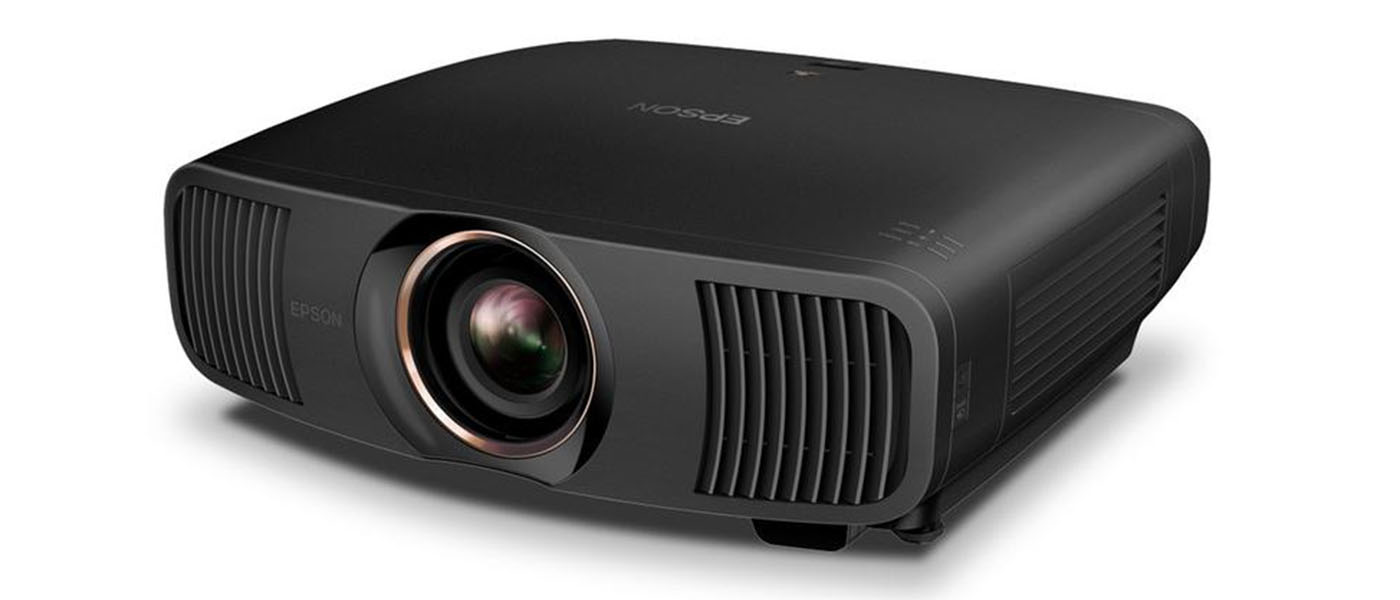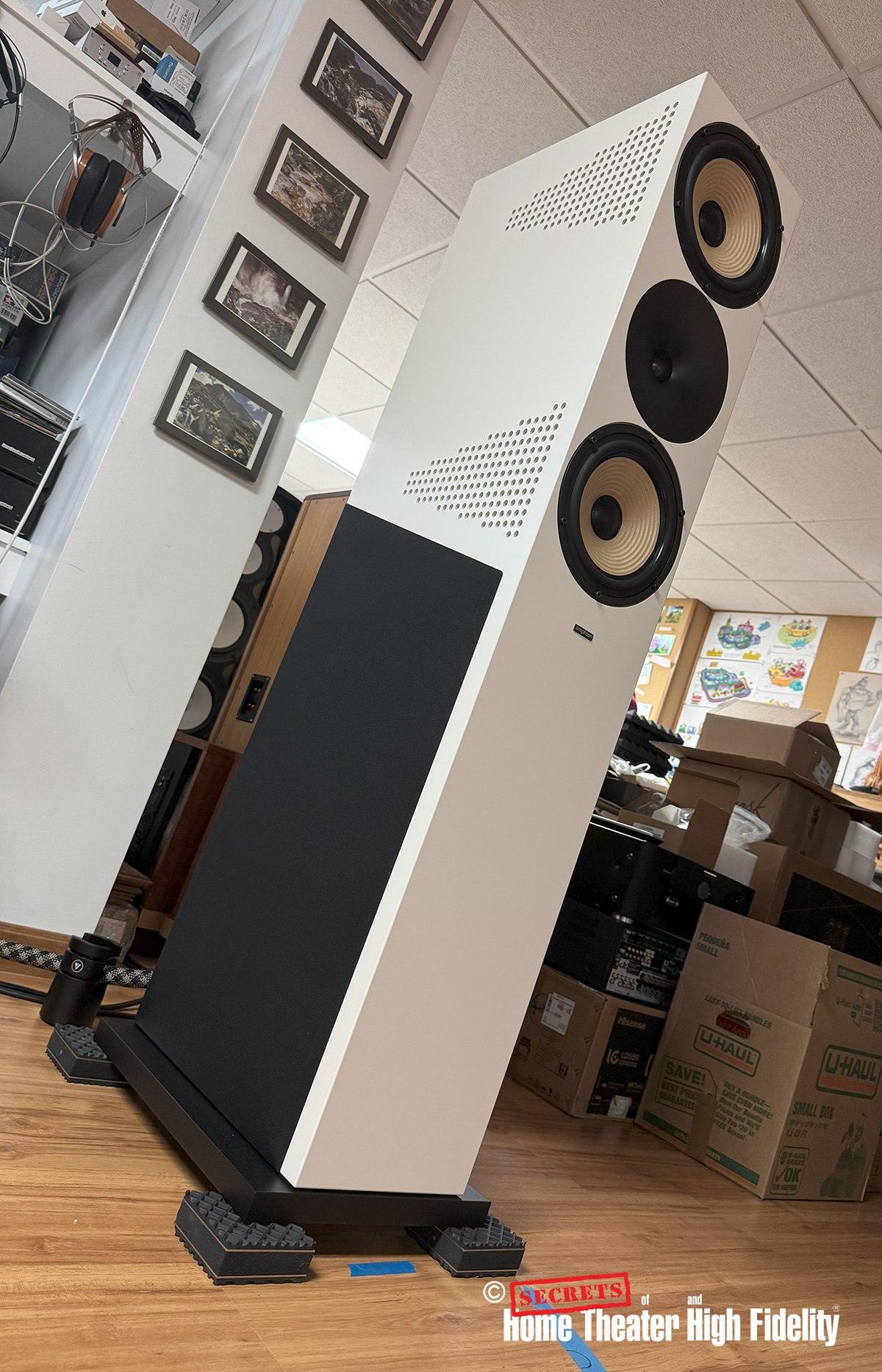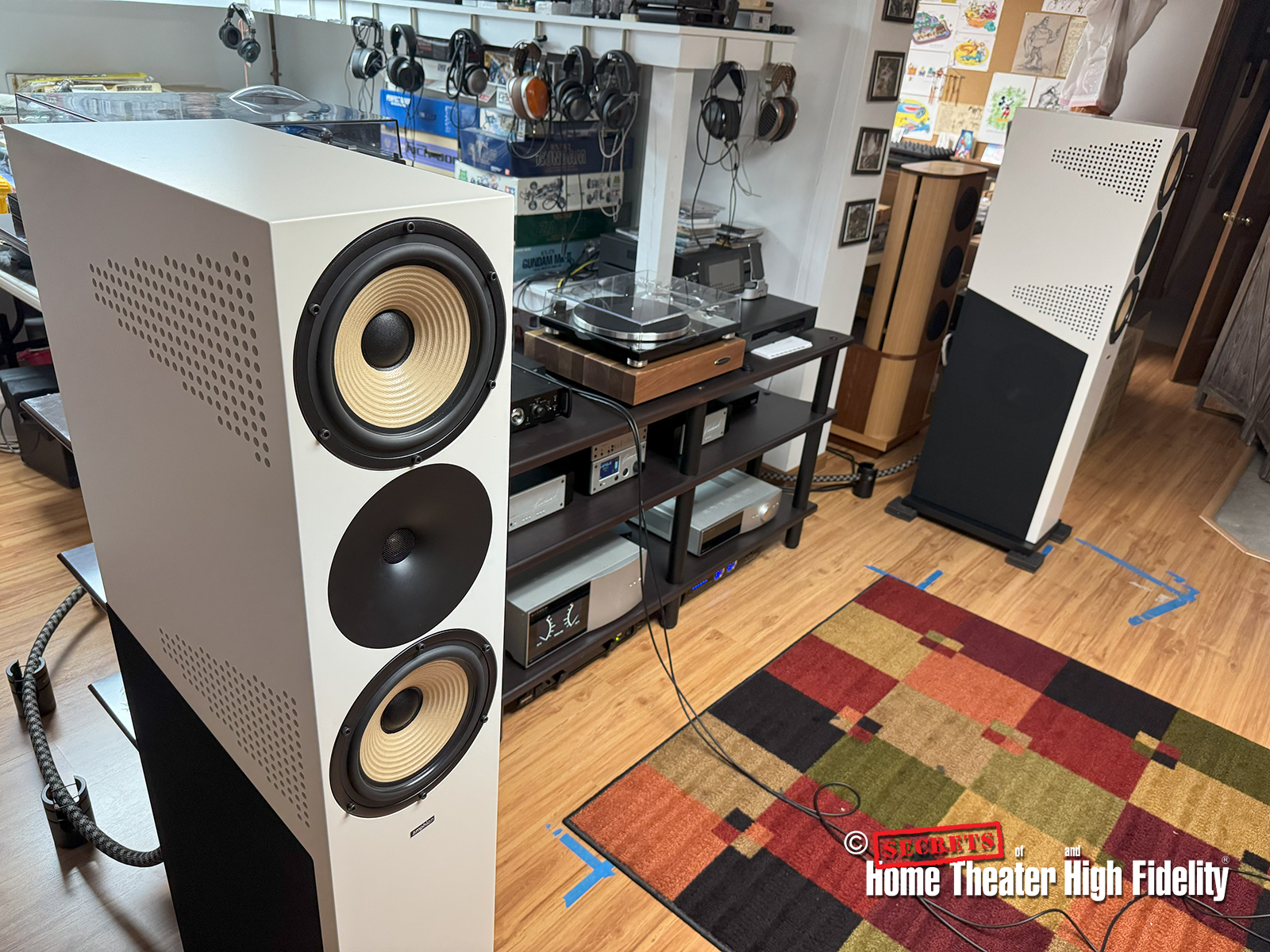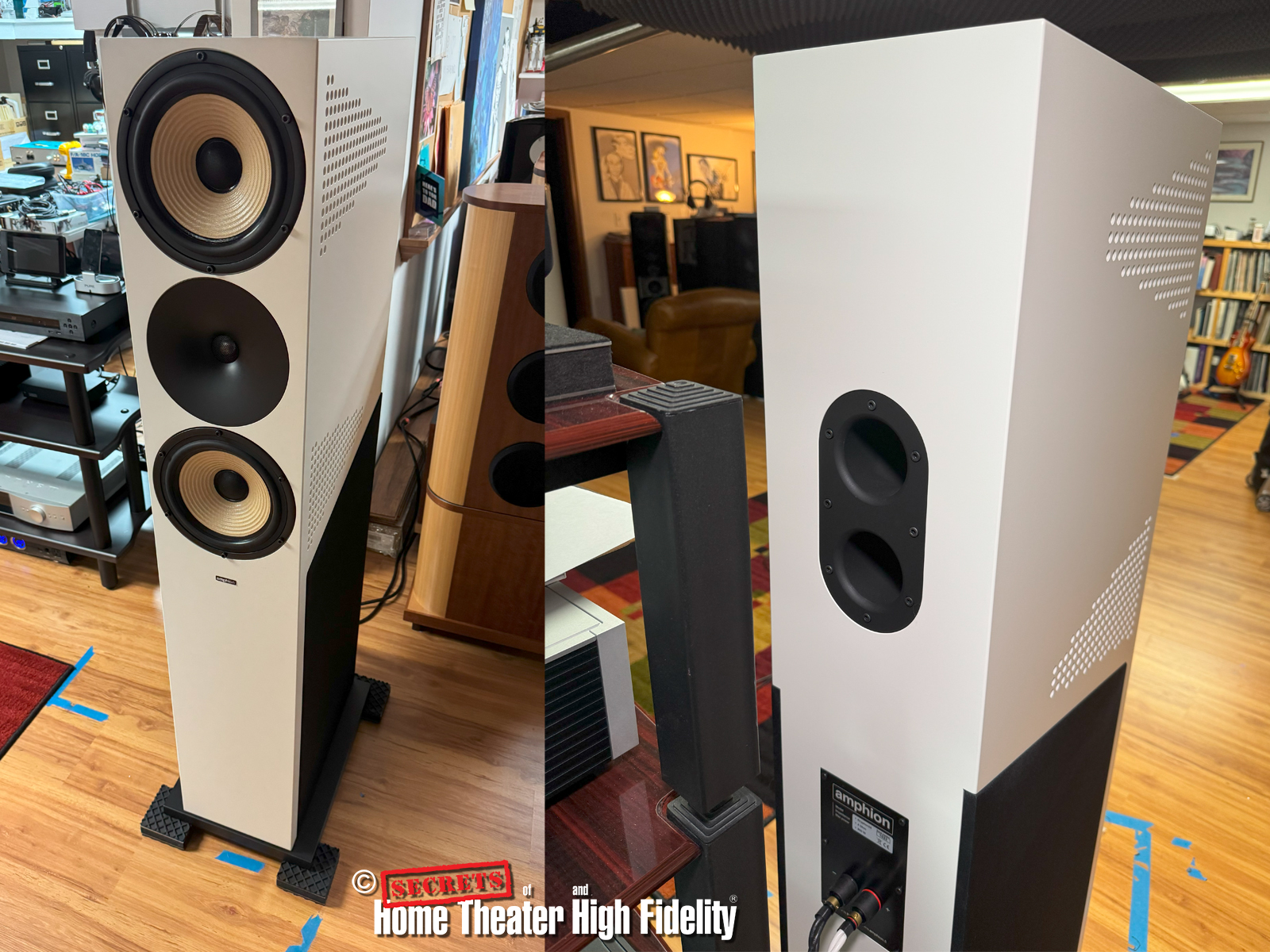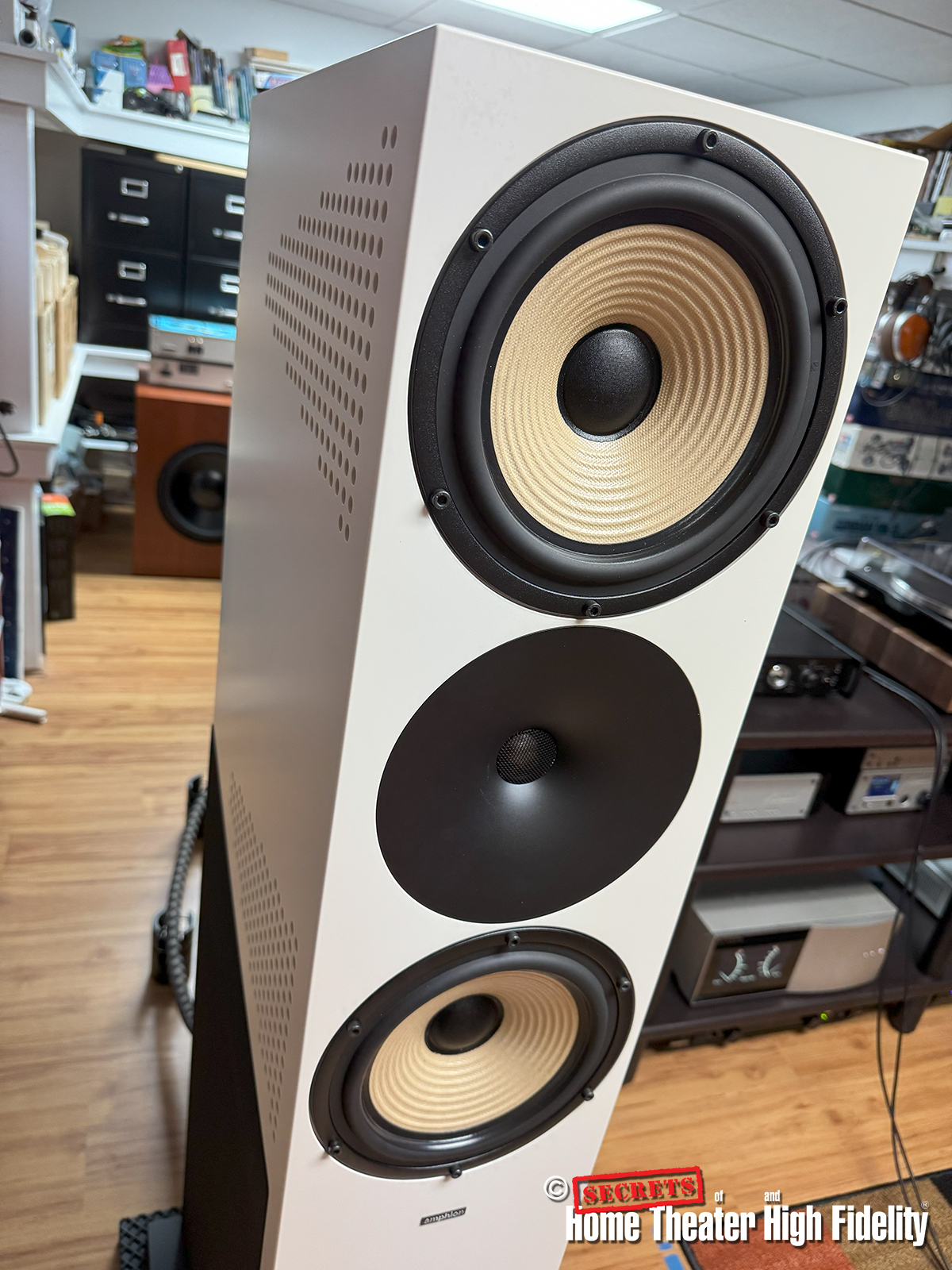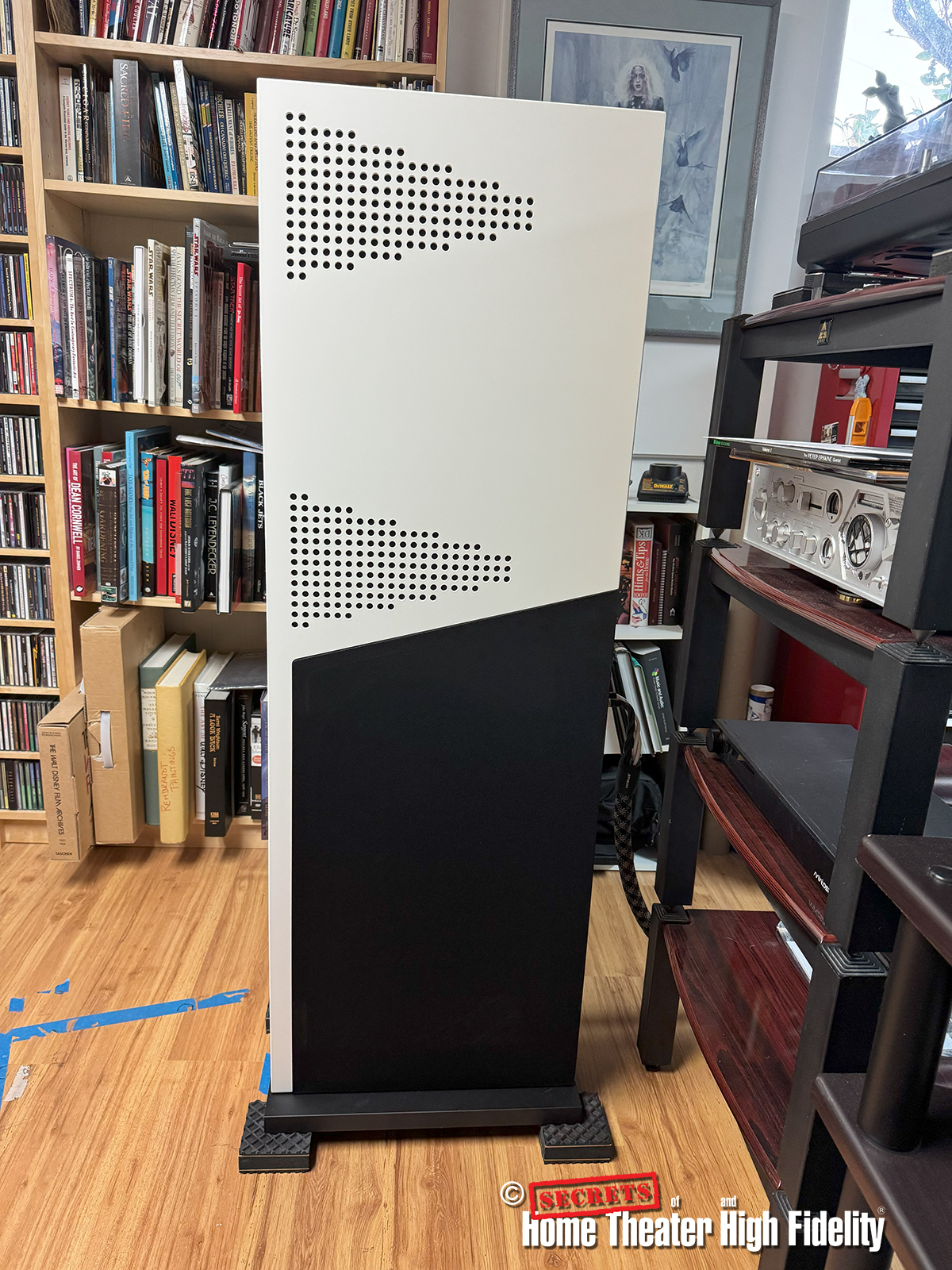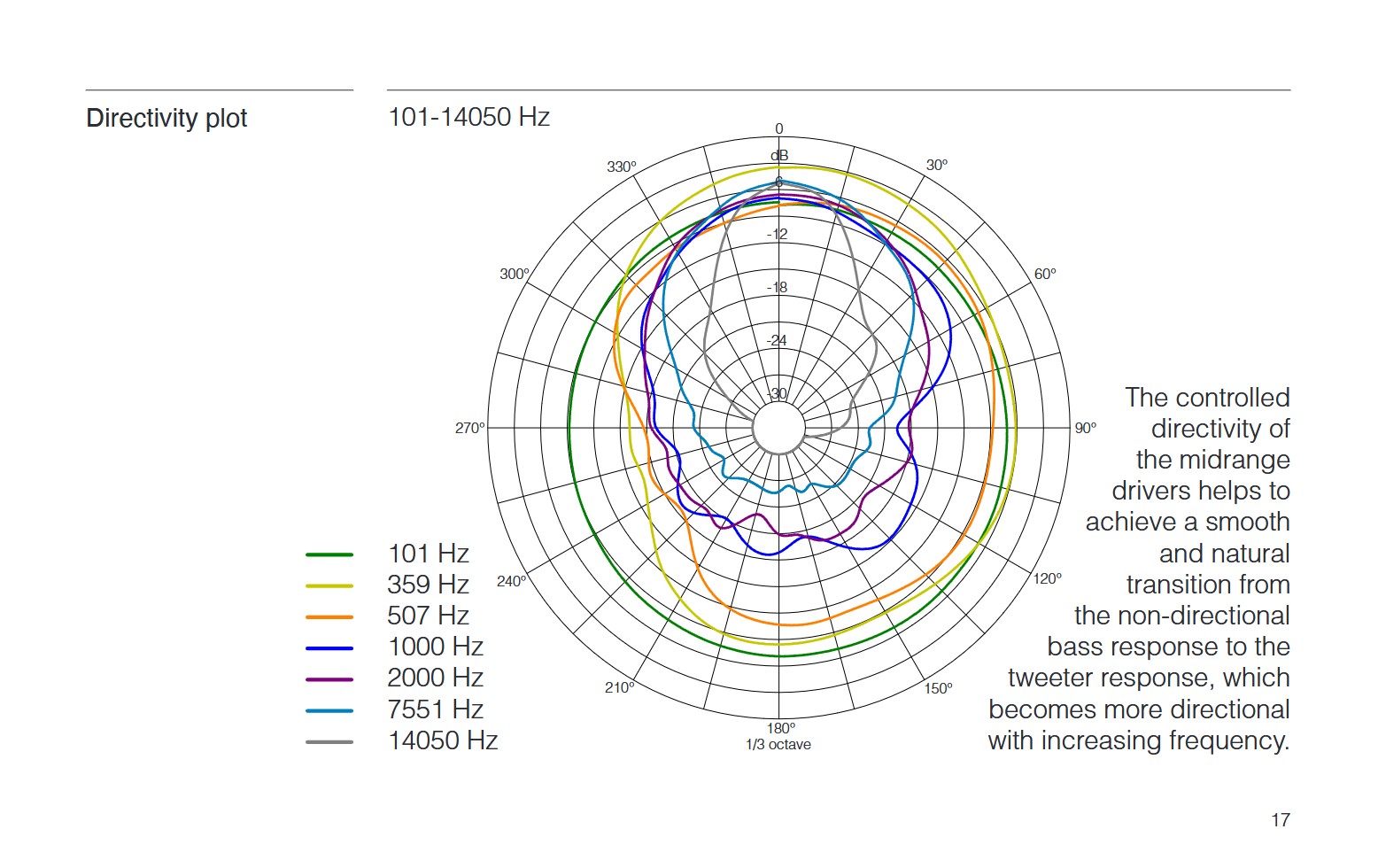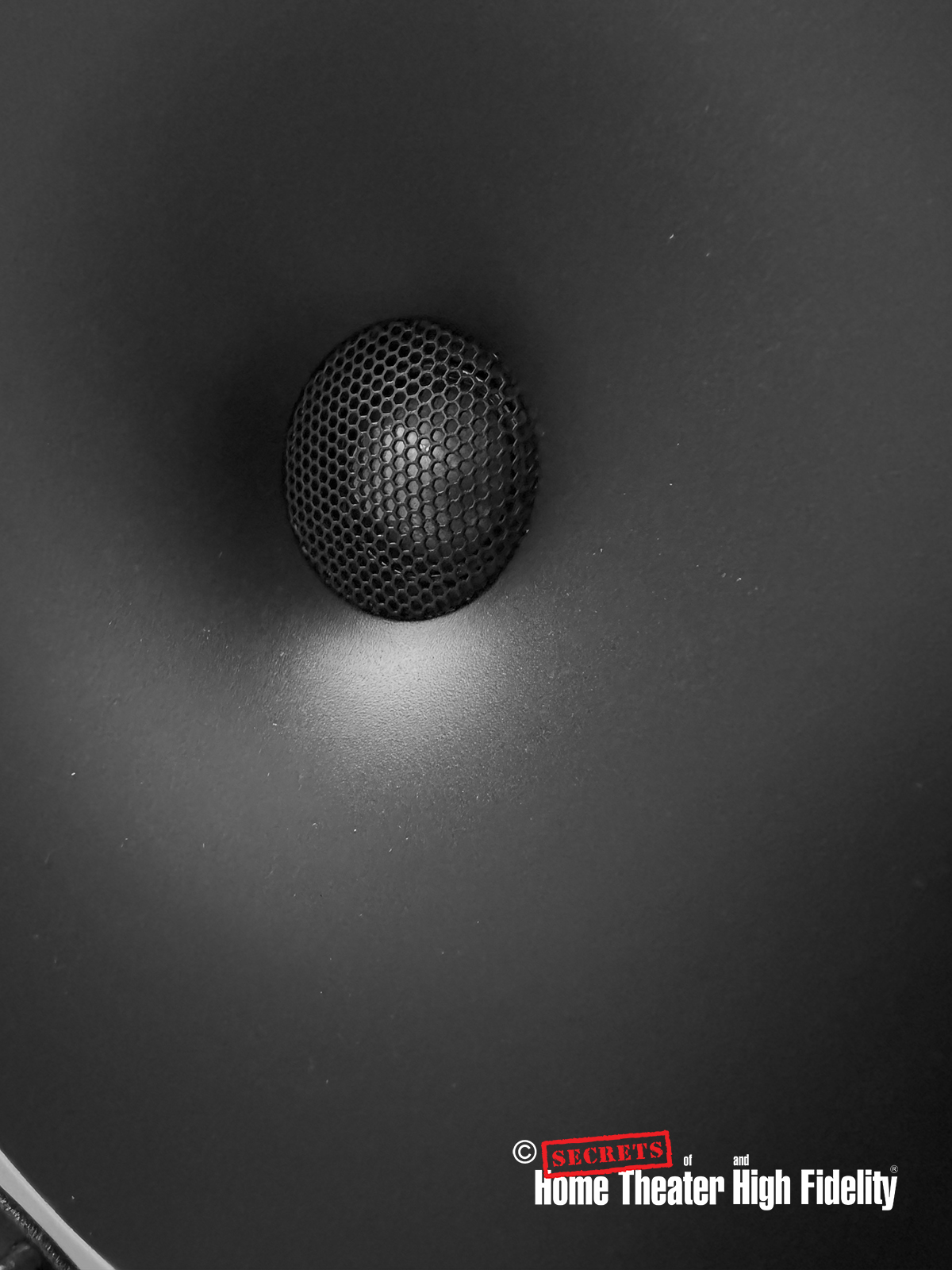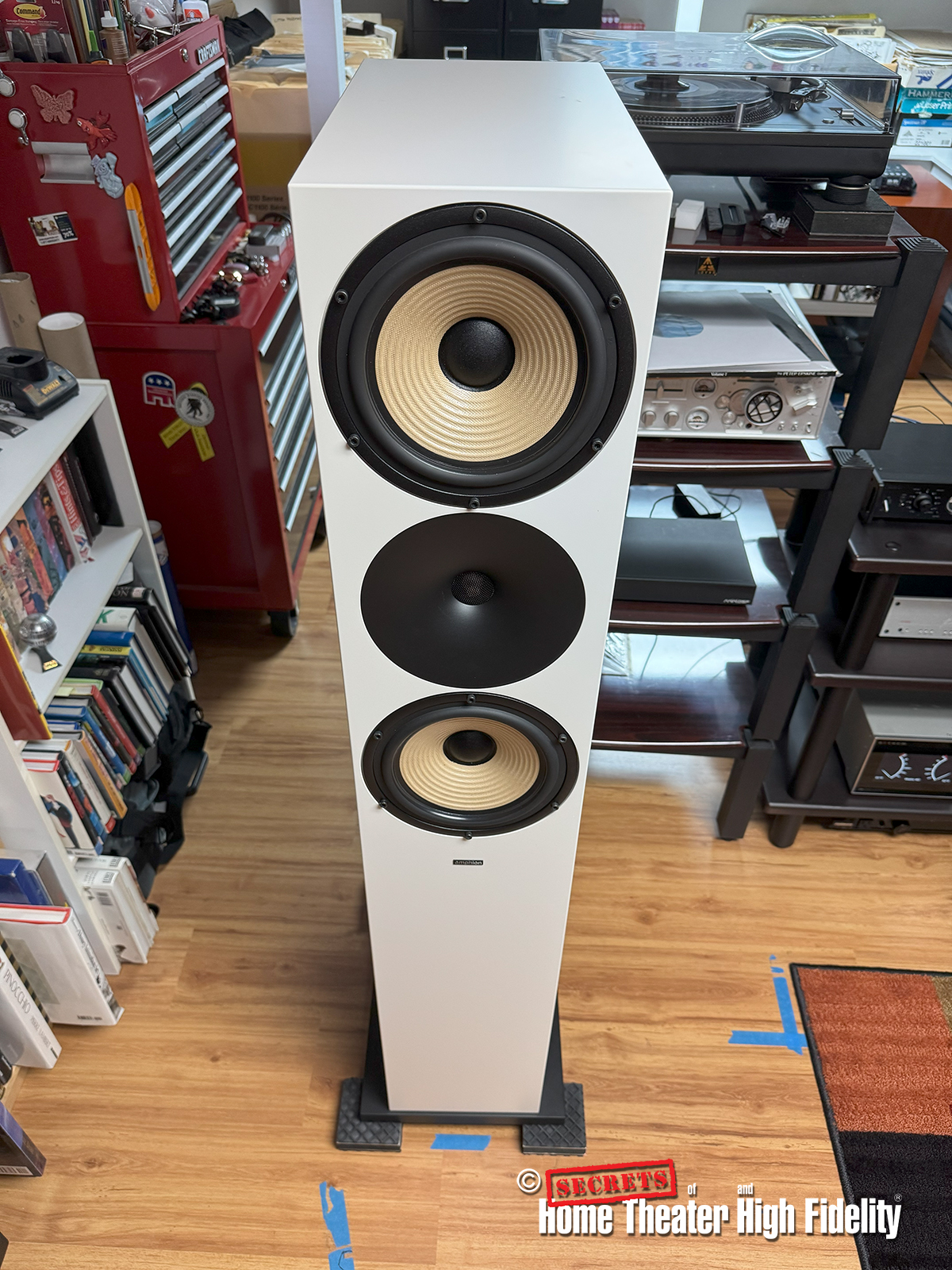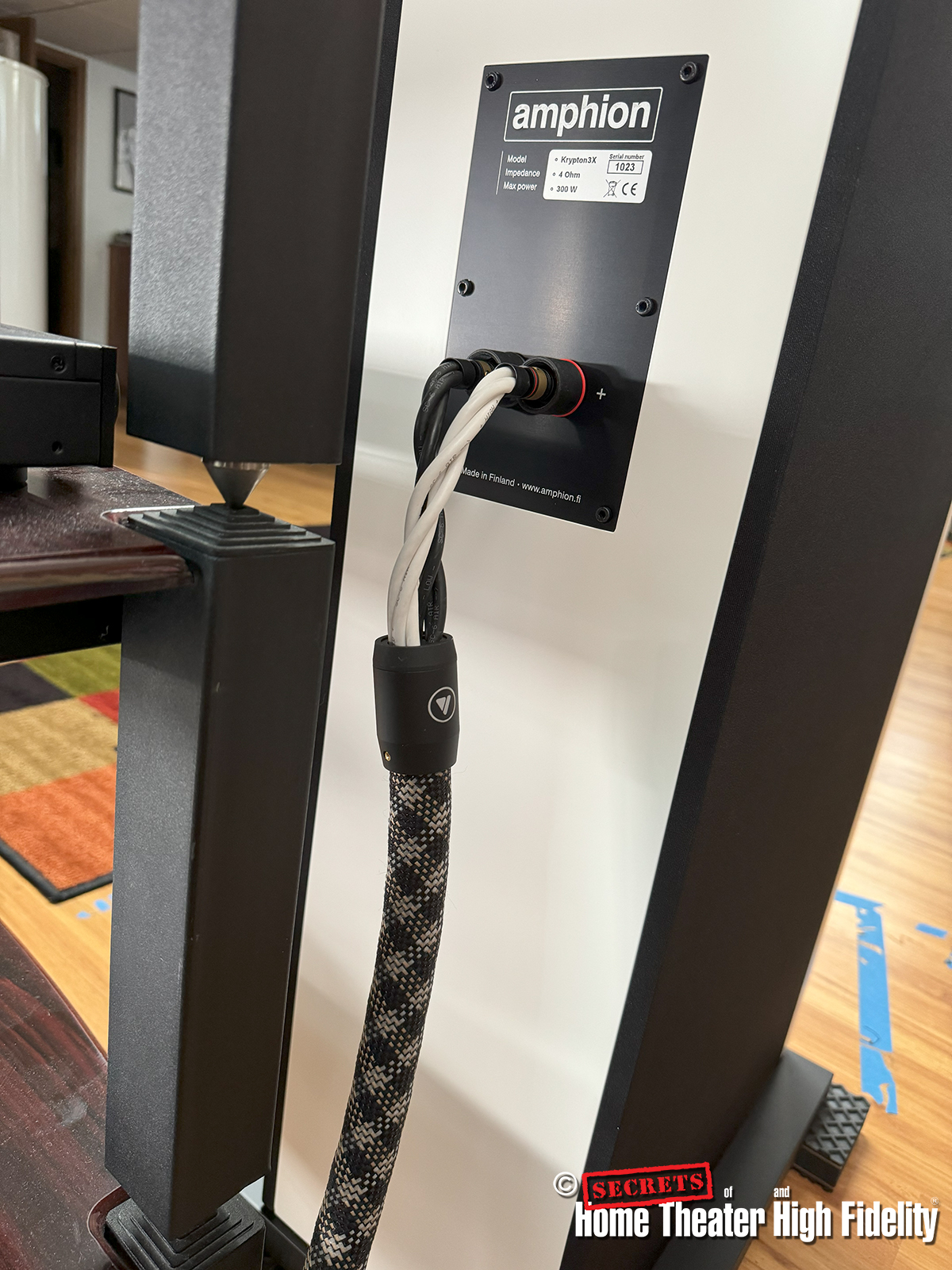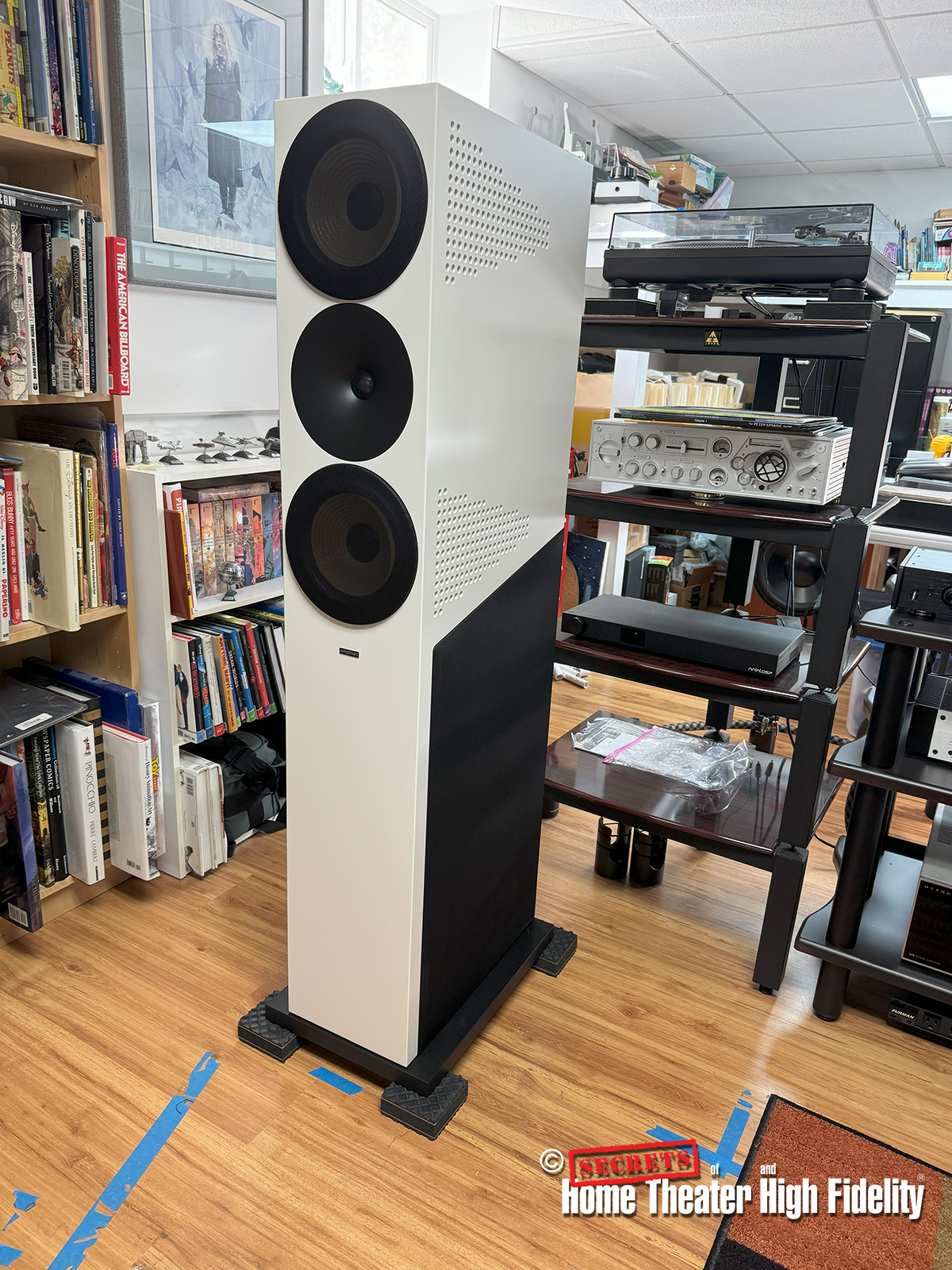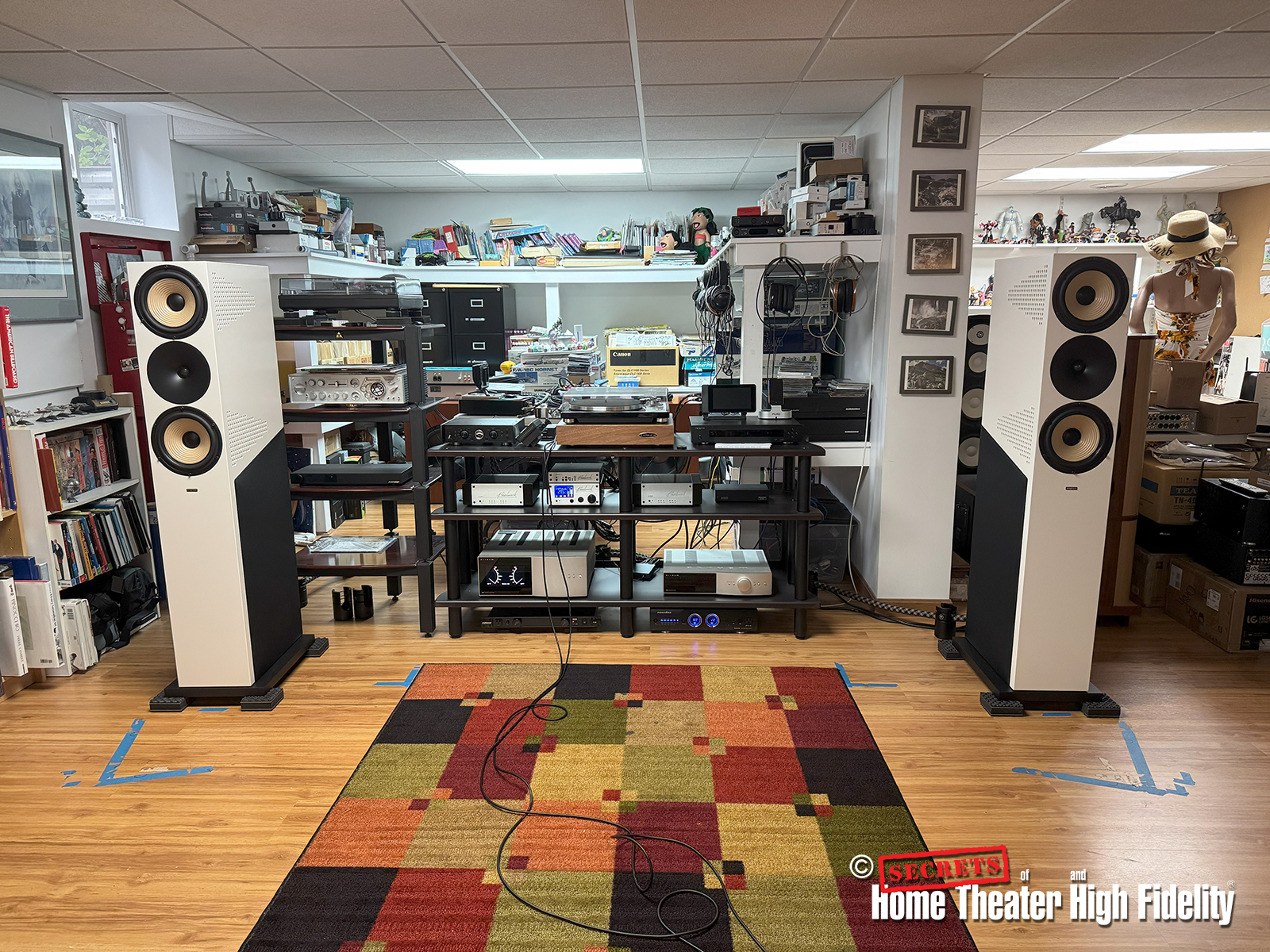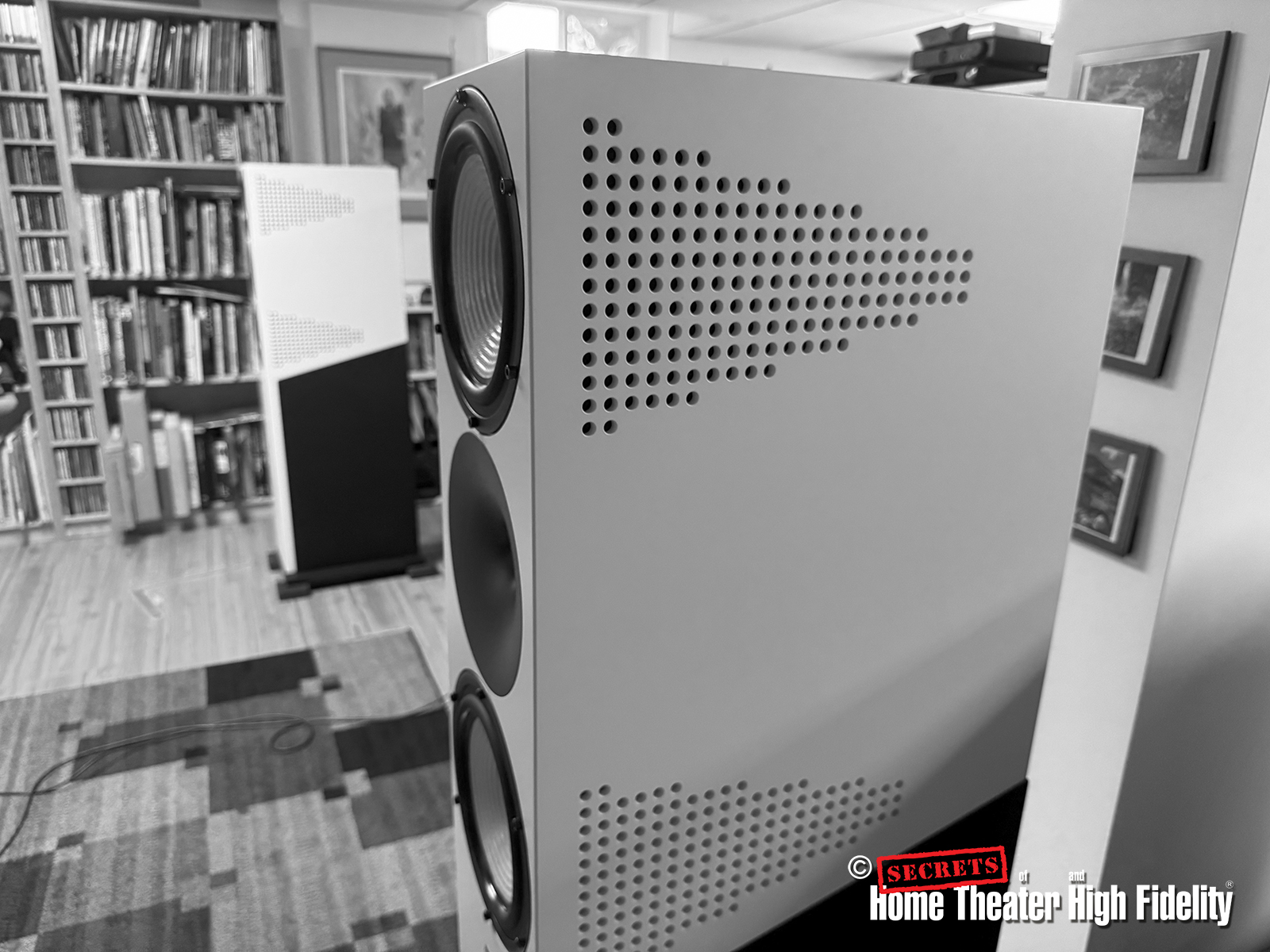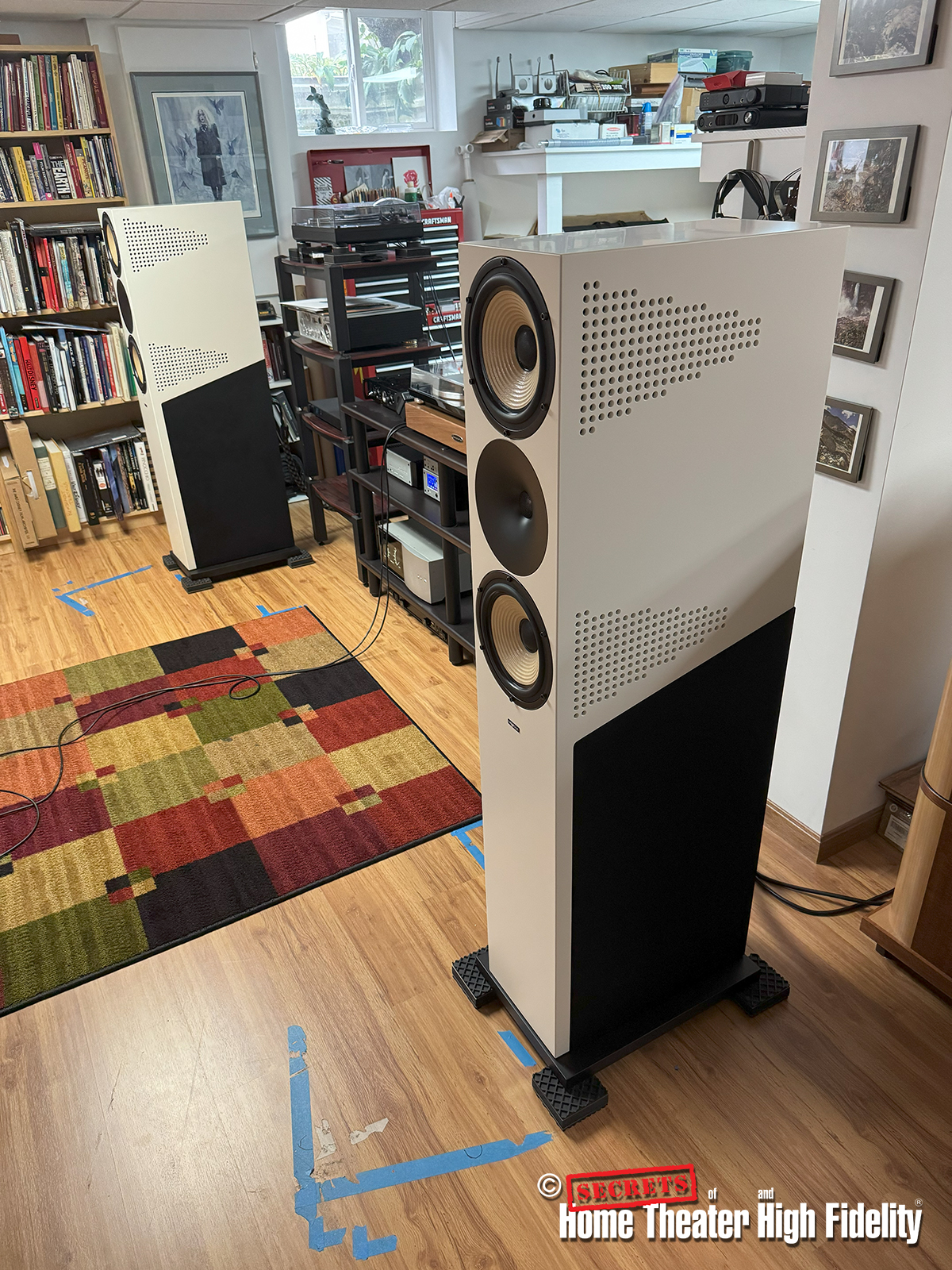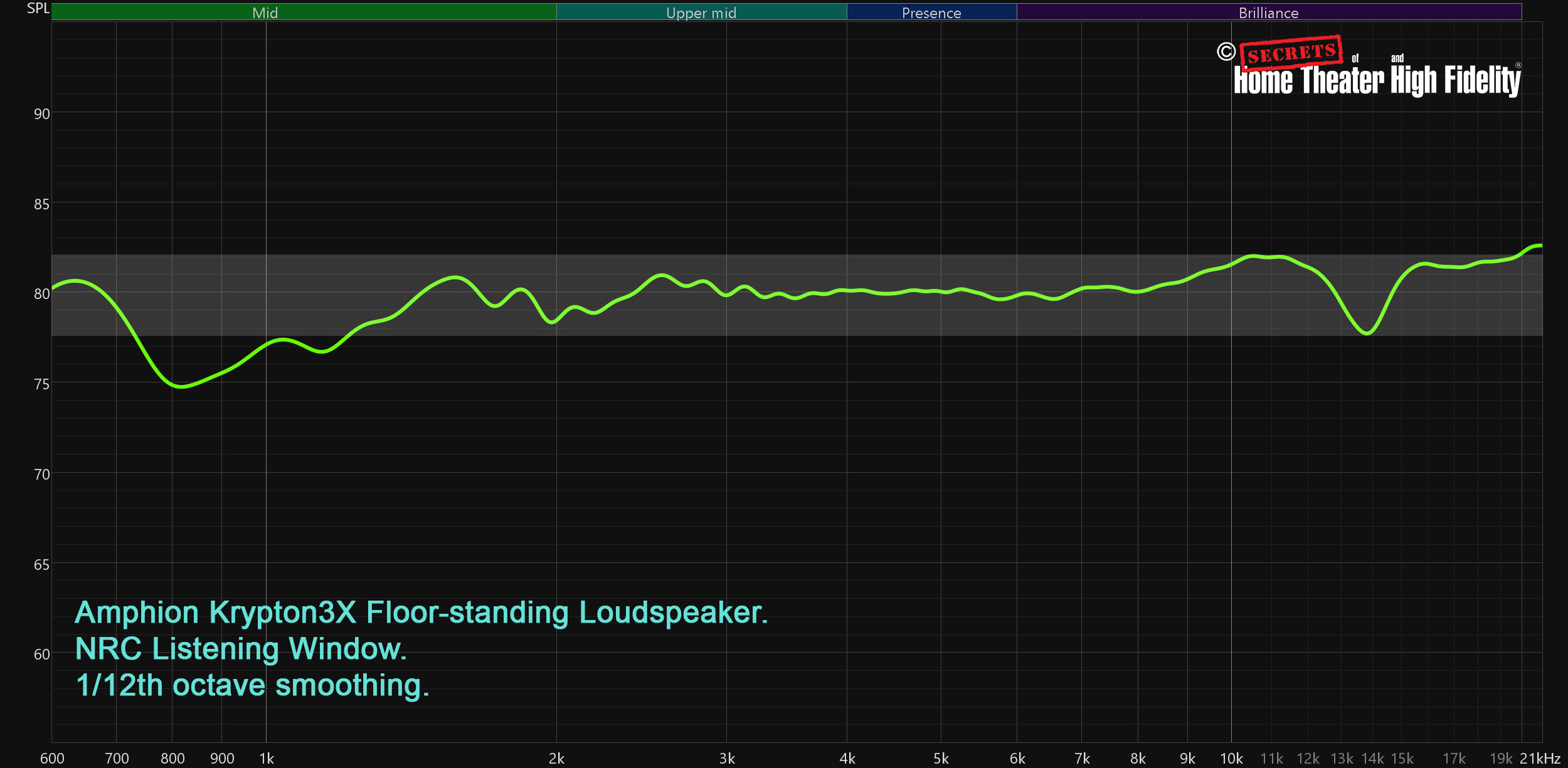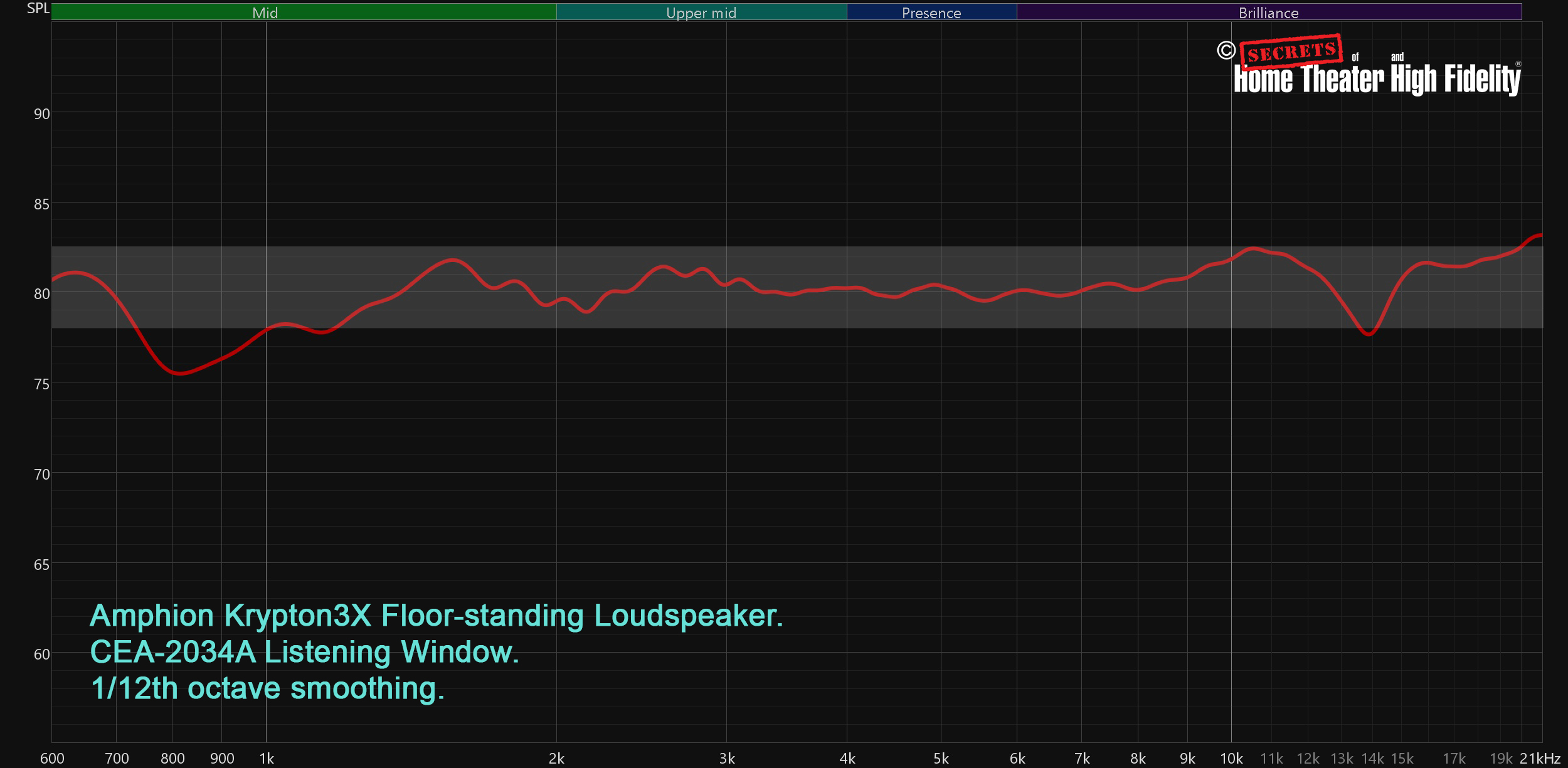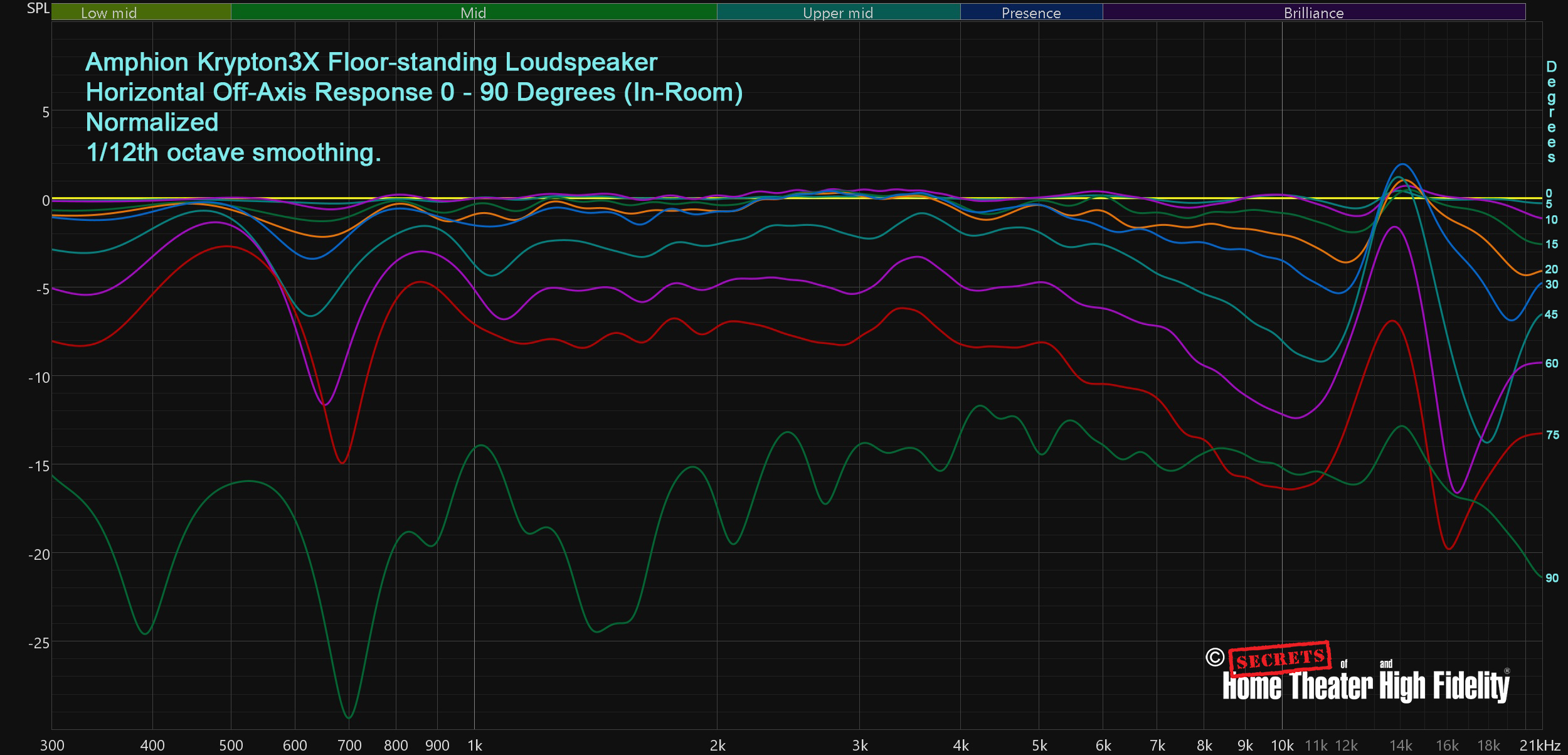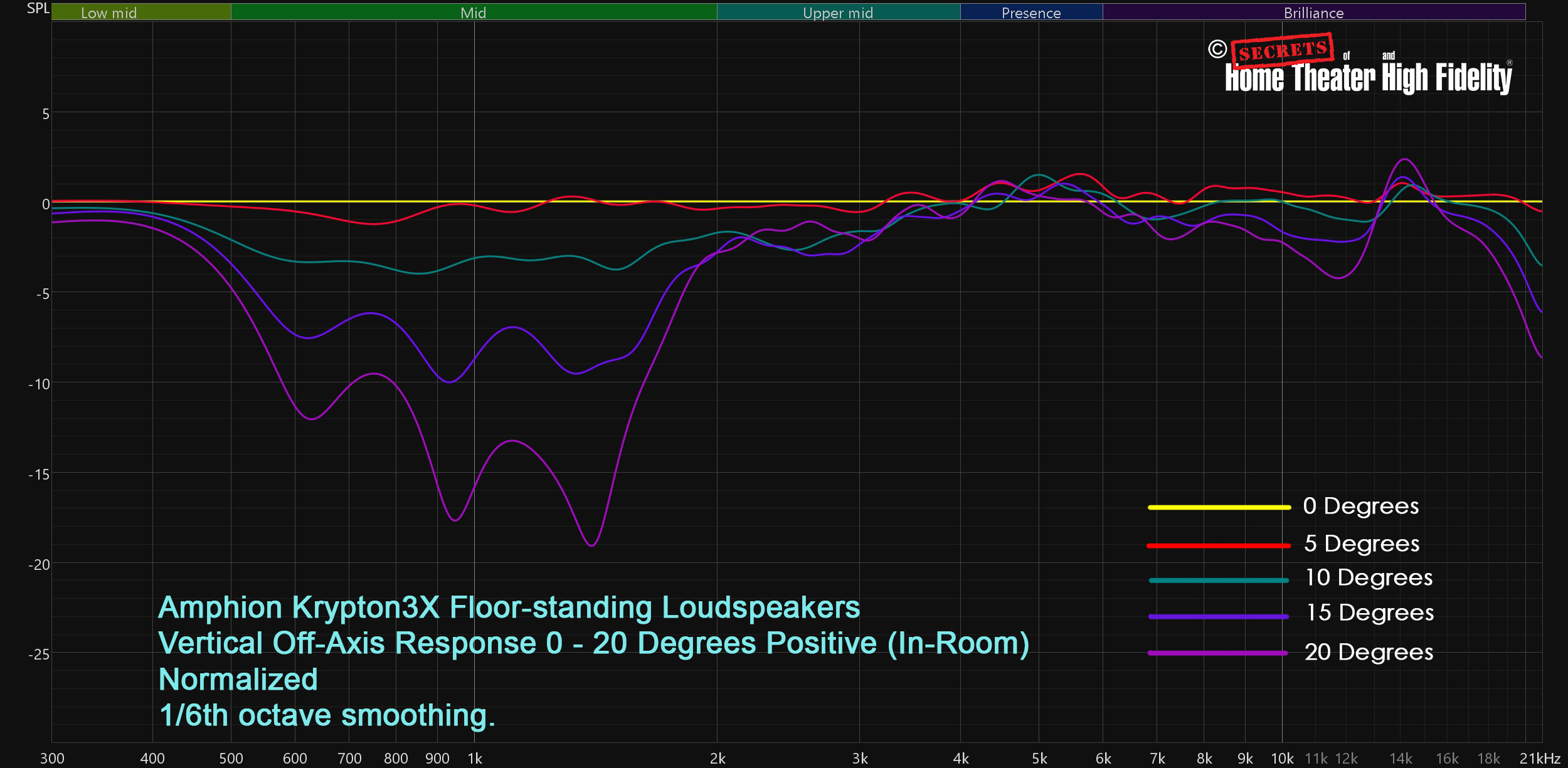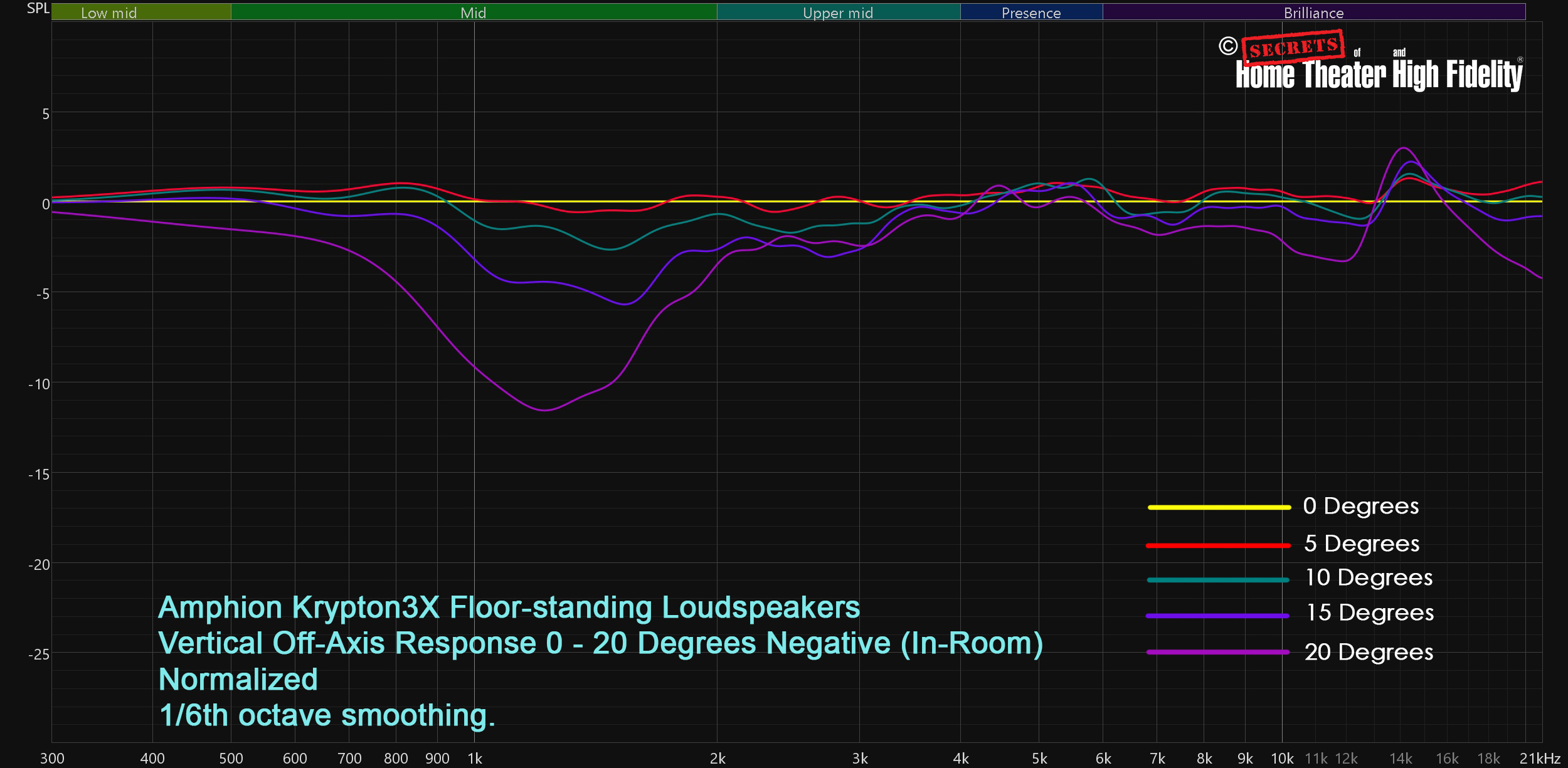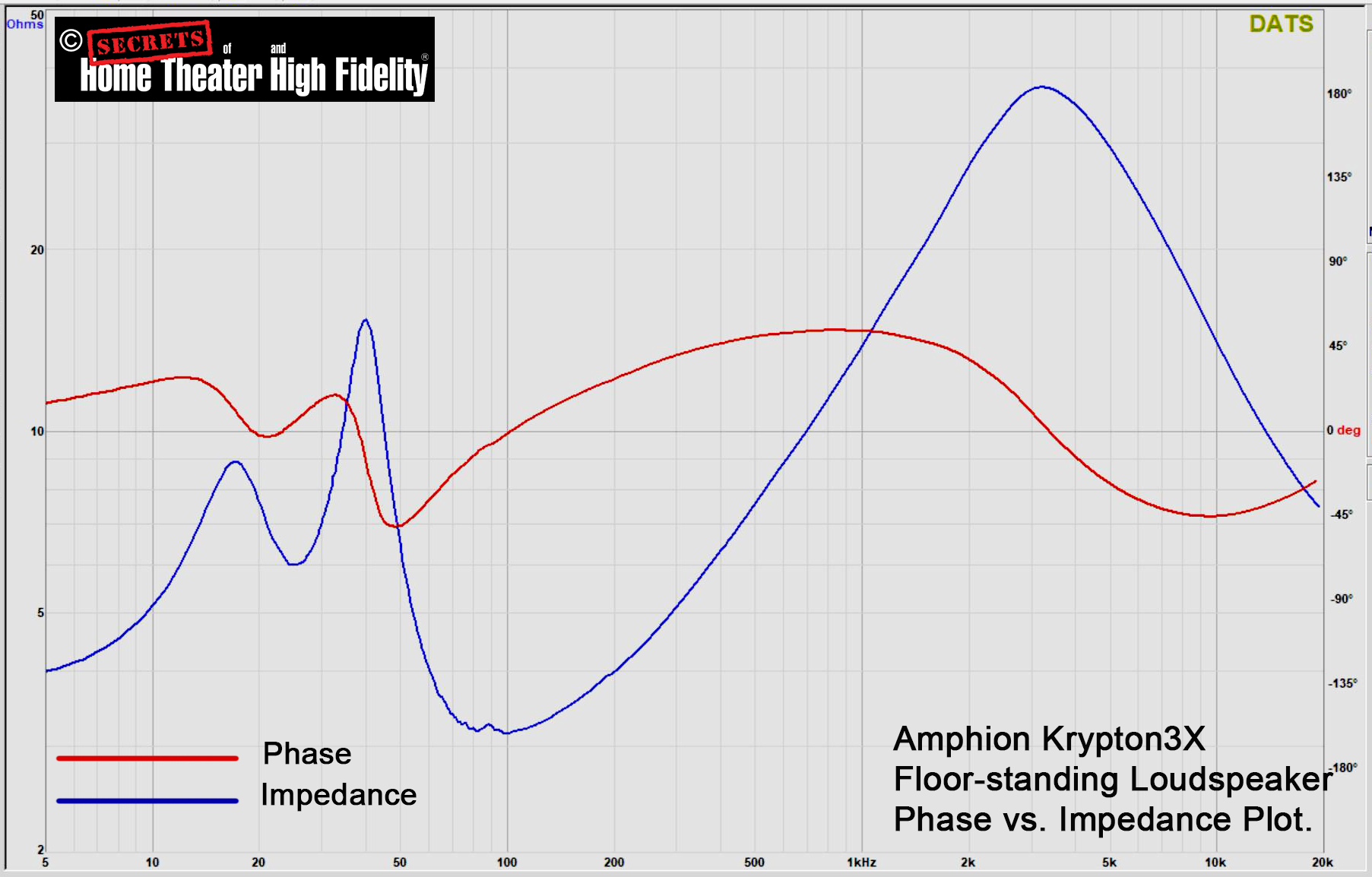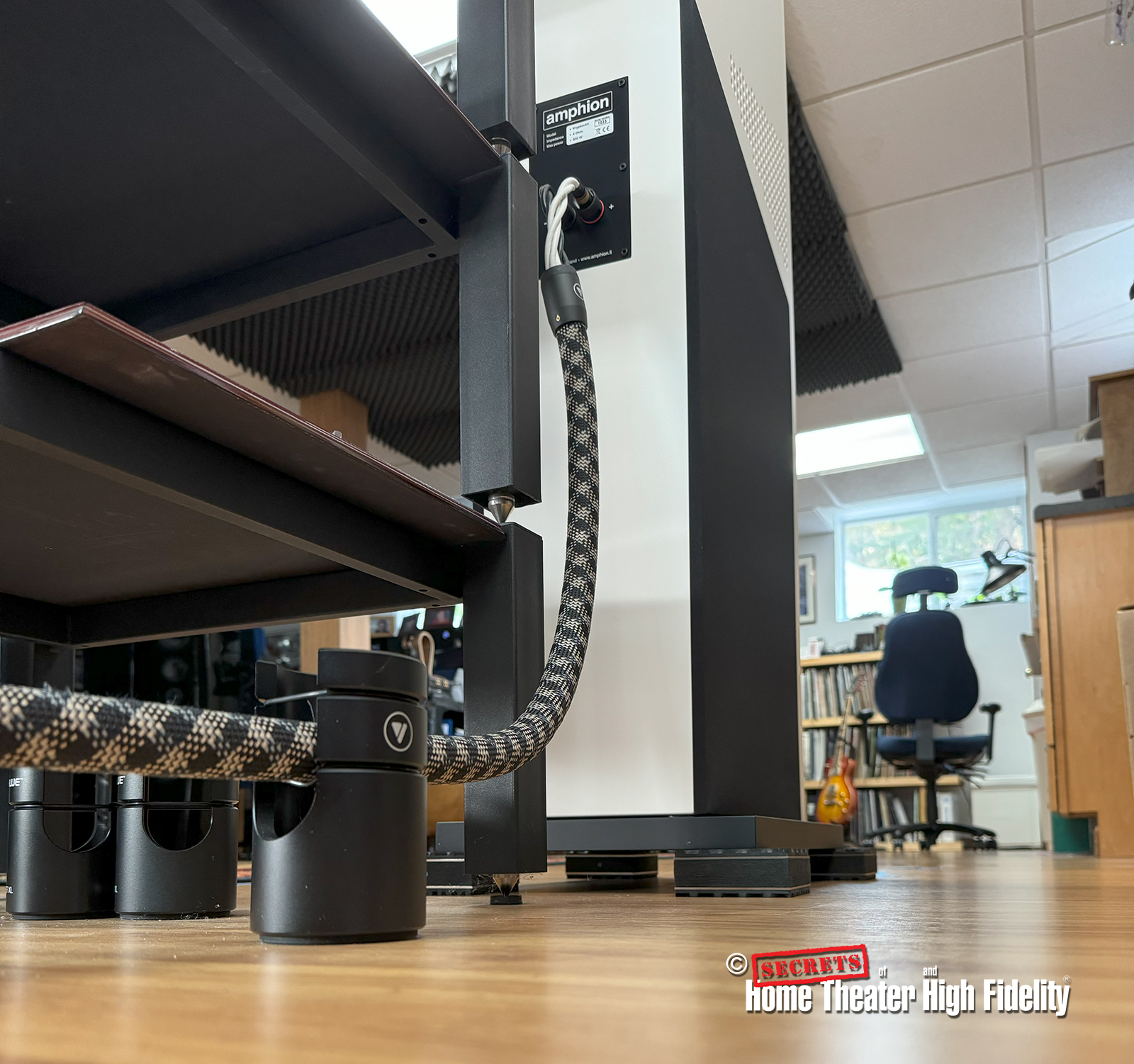Sporting a clean Scandinavian design and some innovative technical approaches derived from the professional music world, the Amphion Krypton3X makes for an attractive and potent music delivery system. It is the fifth version of Amphion’s flagship loudspeaker, having evolved over the past 25 years.
Amphion Krypton3X Floor-Standing Loudspeaker
- Truly full-range loudspeakers with usable bass output down to 27 Hz in my large room.
- 25 mm Titanium tweeter in a large custom waveguide for better dispersion and smooth transition to mids.
- Dual 8″ midrange drivers offer more displacement/lower distortion of critical frequencies and lower crossover to bass.
- 10″ side-firing bass drivers can be positioned facing in or out depending on the room.
- The cardioid midrange dispersion pattern offers a very natural-sounding and cohesive presentation by claiming to reduce side and back wall reflections.
- Beautifully clean midrange. Vocals, piano, and guitar just shone with these speakers.
- These visually big speakers don’t grab your attention until you listen. They are the ultimate “sleepers!”
There is something in the water surrounding Nordic countries when it comes to audio design. Starting from Denmark in the Scandinavian peninsula and extending up into Finland, Sweden, and Norway one will find more highly innovative and accomplished HiFi audio brands calling this region home than almost anywhere else. I got my first introduction to this powerhouse of audio geography during my visit to DALI in 2022 (https://hometheaterhifi.com/features/factory-tours-interviews/dali-speakers-press-conference-report-norager-denmark-august-2022-by-carlo-lo-raso/) where I was introduced to not only their capabilities and history but also the breadth of the audio industry as a whole in this region. There are literally dozens of well-known, and dozens more lesser-known, brands to discover here, and standing among them, almost in the middle of Finland, is Amphion.
Amphion began in 1998 and builds well-regarded active and passive monitoring solutions (including subwoofers) for music production. They have leveraged much of their know-how and technology on the pro side into the three lines that they offer on the consumer end of the business. The Krypton line is Amphion’s highest-end category and currently is home to only a single loudspeaker model, that being the Krypton3X that we have here today.
For those looking for a compelling and satisfying full-range loudspeaker, the Amphion Krypton3X may not immediately jump to the top of their mind as an option. But with the novel optimized tweeter waveguide, the cardioid midrange dispersion pattern, and the updated crossover with a lower handoff to the woofers, all wrapped in a stylishly understated hand-built enclosure, it has all the makings of a winning combination. So, let’s put aside the pickled herring for a moment and focus on spending some quality time with this other Nordic delicacy, shall we?
Design:
3-Way, 4-Driver Bass Reflex Floor-standing Speaker
High Frequency Drivers:
Single 1′′ Titanium dome tweeter inset into a large waveguide
Mid-Range Drivers:
Two 8′′ Ribbed Papyrus mid-range drivers in Cardioid enclosures
Bass Driver:
Single 10′′ side-firing Aluminum coned woofer
Frequency Response:
21 Hz – 55 kHz -3dB
Crossover Frequencies:
160 Hz, 1.6 kHz
Recommended Input Power:
100W – 300W
Sensitivity:
89dB (2.83V, 1m)
Nominal Impedance:
4Ω
Weight:
154 lbs. or 70 kg. (each)
Dimensions (H x W x D):
55.12′′ x 13′′ x 18.9′′
MSRP:
$24,000/pair
Finishes:
Satin White, Satin Black, Satin Walnut
Accessories:
Two mid-range grilles, speaker spikes (with hard floor discs) x 4, cleaning cloth, owner’s manual.
Website:
Company:
SECRETS Tags:
Amphion, waveguide, cardioid, floor standing, Finland
Secrets Sponsor
At its core, the Krypton3X is a substantial MTM (midrange-tweeter-midrange) tower loudspeaker with a large side-firing bass driver and a pair of ports in the back. The enclosure is a large rectangular box on a simple plinth. Straightforward and unassuming enough, right? Look closer however and the details start to look a bit more compelling. That MTM array? Those are two very big 8-inch drivers that flank the tweeter.
And those cones? A proprietary paper/papyrus combination (which sounds more exotic than wood and cane) that is pressed with a concentric ribbed pattern, maxing out that surface area and punching up the rigidity (this equals lower distortion and more detail). Those drivers are enclosed in their own separate chambers within the cabinet, vented on either side with a unique triangular pattern of vent holes on both sides of the cabinet. This produces a cardioid dispersion pattern through the midrange and upper-bass bands. The sound radiates out of the side vents 180 degrees out of phase with the cone radiation out of the speaker front. Radiation from the front side of the cones is canceled at the sides of the speaker by the sound coming out of the vents.
This heart-shaped projection method which concentrates more of the sound forward toward the listener can help minimize side and front wall reflections and improve speaker performance in smaller rooms or near room boundaries.
In this directivity plot from Amphion’s literature, it can be seen that the energy at the side and back is reduced. A strange asymmetry is seen at 400Hz and 500Hz. It attenuates from 0 degrees to 210 degrees, but nothing happens from 0 degrees to 110 degrees.
By way of interest, another example of speakers incorporating a cardioid dispersion design is the Dutch & Dutch 8c. It also has vents on its sides which appear as single, slim vertical rectangles. Dutch & Dutch also incorporates DSP into the mix as opposed to Amphion’s passive approach here. The Krypton3X and the Dutch & Dutch 8c both use 8-inch midrange drivers. This is no coincidence as the 8-inch driver’s output becomes more directional at 1.25 kHz.
The tweeter is a 1-inch Titanium dome set in a large waveguide. The deep waveguide on the tweeter narrows its horizontal response to match the top-end response of the unique cardioid midrange. Both the tweeter and the 8-inch midrange drivers are designed to have matching radiation patterns at the crossover point of 1.6 kHz. This is similar in fashion to the aforementioned Dutch & Dutch speaker.
David Rich notes:
The potential issue with this approach is that the tweeter is crossed over at a very low frequency. Typically, a tweeter would crossover at 2.5 kHz – 3.5 kHz. Using a low 1.6 kHz crossover, as Amphion does here, can cause the tweeter to distort since the driver displacement becomes very large. Displacement increases as frequency goes down. It is asking an awful lot of the 1-inch tweeter. Dutch & Dutch uses high-order DSP crossovers and limiters. Amphion claims its tweeter can work down to 1.6 kHz with a passive crossover and no limiter or fuse protection.
Unlike the Dutch & Dutch 8c, which has a single 8-inch midrange in a small box that limits distortion at its bottom end, Amphion doubles the midrange count to two drivers. This is the equivalent of a single 10-inch midrange in cone area.
As can be seen from the speaker photo, the two 8-inch drivers are placed symmetrically around the tweeter. The side vent holes are also mirrored around the second woofer.
This is an MTM configuration. These are well known to produce poor vertical radiation characteristics, and the two drivers interfere with each other, resulting in a significant energy loss around the crossover, as we shall see below.
In a typical speaker design, side vent holes are not used for cardioid horizontal radiation; a 3.5 or 4-way design is used. In such cases, a single midrange of about 5 inches would be used, which would then cross over to a larger lower midrange driver.
Amphion cannot do that. They need the optimally sized 8-inch midrange drivers to get the dipole radiation to the tweeter waveguide. They also want the midrange pair to produce low distortion to the subwoofer crossover to keep the cardioid radiation pattern for the full frequency range the midrange operates at.
Thus, the MTM configuration becomes required to achieve a dipole radiation pattern at low distortion in a passive speaker configuration. The non-ideal vertical radiation pattern is a cost that has to be lived with as a trade-off for the dipole.
In an active DSP speaker like the Dutch & Dutch and the Kii Three, smaller woofers can be placed on the sides and back to achieve the dipole radiation. The DSP sets the delays to match the driver’s placement.
All this allows the MTM to be crossed over to the 10-inch woofers at a fairly low 160 Hz. This is intended for an overall better, more predictable in-room performance in the upper bass region. That 10-inch woofer is a side-firing, aluminum coned affair with a substantial surround allowing for a good amount of excursion. Amphion suggests that, for smaller rooms, the speakers be positioned with the woofers firing inwards, whereas an outward orientation is recommended when the Krypton are in larger spaces. Experimenting is of course recommended, as every room is different, and I definitely preferred the sound one way over the other after I tried both orientations.
Even when taking a closer examination of the cabinet design, initial preconceptions require some revisiting. Yes, it is a large rectangular box, but that contrast of the narrower front baffle against the extended depth of the enclosure and the skinny plinth makes for some visually interesting proportions. Adding the designs of the pointillist triangular vents and angled black lower-half side panels to either side of the speakers helps break up all the brutal 90-degree angles of the main box. If there was ever a way to make basic geometry look elegant in three dimensions, the folks at Amphion cracked the code. Especially with the speakers clad in the Walnut finish. Aesthetically, they just exude class. For the review, I had to “settle” for the Krypton3X in white. Meh! First-world problems, indeed!
There are surprisingly only a single pair of speaker binding posts to be found on the speaker’s back panel. The chunky terminals can accept banana plugs, spades, or bare wire as needed without fuss. Leave any notions of bi-wiring or bi-amping these speakers at the door. This fits with much of the underlying design philosophy at Amphion. They make a point of mentioning how they like to keep things (both visually and electrically) as simple and direct as possible. Those speaker terminals? They connect directly to the crossover board. No wires.
The speakers come with individual round grille covers for the midrange drivers that can easily be removed if desired.
After they arrived, I got underway by placing the Krypton3X in my usual starting position for larger speakers in my studio, that being just over 9 feet apart with the listening position parked slightly more than 10 feet away from the center point between the speakers. After some fussing around with the distance between the speakers, I settled for them back in the starting position as that seemed to get me the best-sounding results. From an imaging standpoint, I found that I liked what I was hearing from the Amphions with them pointing straight into the room, no toe-in was necessary for my ears.
When it came to sorting out the bass, I found that I preferred the low-end impact I was getting from the Krypton3X with the bass drivers pointed inward, and my room is on the larger side. So, while contrary to indication, it always pays to experiment. Sometimes you never know how your room will mesh with a speaker. Some of the equipment used in the review consisted of the following:
– HiFiRose RA 180 Integrated Amplifier.
– Benchmark AHB2 Power Amplifier.
– Benchmark DAC3 B Digital to Analog Converter.
– Benchmark HPA4 Preamplifier.
– Anthem STR Power Amplifier.
– OPPO BDP-105D Universal Disc Player.
– GeerFab D.BOB Digital Breakout Box.
– DIY Raspberry Pi-based Endpoint.
– Technics SL1200 Mk6 Turntable modified by KAB Electroacoustics.
– Audio-Technica ART20 MC Phono Cartridge.
– TEAC PE-505 Fully Balanced Phono Preamp.
– Viablue Interconnect and Speaker Cable.
– EVP Absorbers from AV Roomservice.
Amphion’s professional pedigree comes through loud and clear through the Krypton3X. There are speakers out there that I would categorize as revealing and detailed to the point of being ruthless. Passing off an exaggerated upper-end response as extended “detail” and “airiness.” The Krypton3X is not such an animal. Extended listening to these speakers made me come away with more of an impression of them being a little more laid back and honest in their presentation. Combined with the sheer size and extension of their sound, it made for a very easy and enjoyable listening experience with every type of music that I threw at them. I found the midrange performance to be particularly notable with vocals and piano. I felt like I was noticing details and nuances in various performances that I hadn’t quite picked up on before. The sense of clarity and transparency I was hearing was excellent.
One of the reasons piano sounded so good with the Krypton3X was how seamlessly the notes transitioned from the middle ranges down through the lower registers. At every point in a well- recorded piano track, the notes had a convincing weight and dimension to their tone. The upper midrange transitioning into the treble region was also very smooth to the ear with plenty of detail and resolution on horns, brass, and strings while not venturing into sounding jarring or overcooked. As relatively big as the Amphions are, they sounded like they played even bigger. While they didn’t have an overly large soundstage, they ran with more of a narrower and more focused presentation, the speakers did have a large dynamic capacity. They loved to be pushed, so when the volume went higher, they scaled really well. For me, these speakers were best enjoyed when sitting in the sweet spot. Sitting well off-axis or listening casually while doing other things in the room didn’t quite grab me as some other speakers might. But sitting in my listening chair, things like massed strings played back at volume over the Krypton3X had a scale and dimension to them that was impressive and memorable.
Then we get down to that bass section. As I mentioned earlier, even in my large-ish room, I found that I experienced more bass impact with the side-firing woofers pointed inward, which is contrary to the prevailing wisdom spelled out in the Krypton3X setup instructions. The bass response itself was powerful and quite extended and remained generally well-controlled in my room. The speakers did cause a little rattling with some objects in the corners of my room which was alleviated by using four AV RoomService EVP isolation pads under each speaker. Make no mistake, these speakers do not need subs. Of course, it’s still okay to want them though, but they won’t be working much. Acoustic and electric bass just sounded tight, deep, and detailed. Not a whiff of bloat to be heard. And everything from hard rock kick drums to orchestral tympani to electronic bass sounded so impactful with these speakers. A good solid 100-watt amplifier is plenty to make these speakers perform, as my Benchmark AHB2 amplifier capably demonstrated. The HifiRose RS180 integrated amp was also a great match with the Amphions, maintaining a wonderful sound quality and reducing the system box count a bit. But I did notice a bit more visceral “oomph” in the speaker’s nether regions when I brought the big Anthem STR power amp online with the Krypton3X. This ended up being a superb overall matchup and the one I ended up spending the longest time with.
If I could compare its tonal quality to another loudspeaker, I would say it has some similarities to the Perlisten S7t. The mids and the highs between both speakers had a similar sound, with the midrange of the Krypton’s being a little more forward than the Perlisten. The Perlisten in contrast had an even more visceral and uniform bass impact in my room. Your (bass) mileage may vary in a different room.
Some of the music that was most memorable to me while listening through the Krypton3X was:
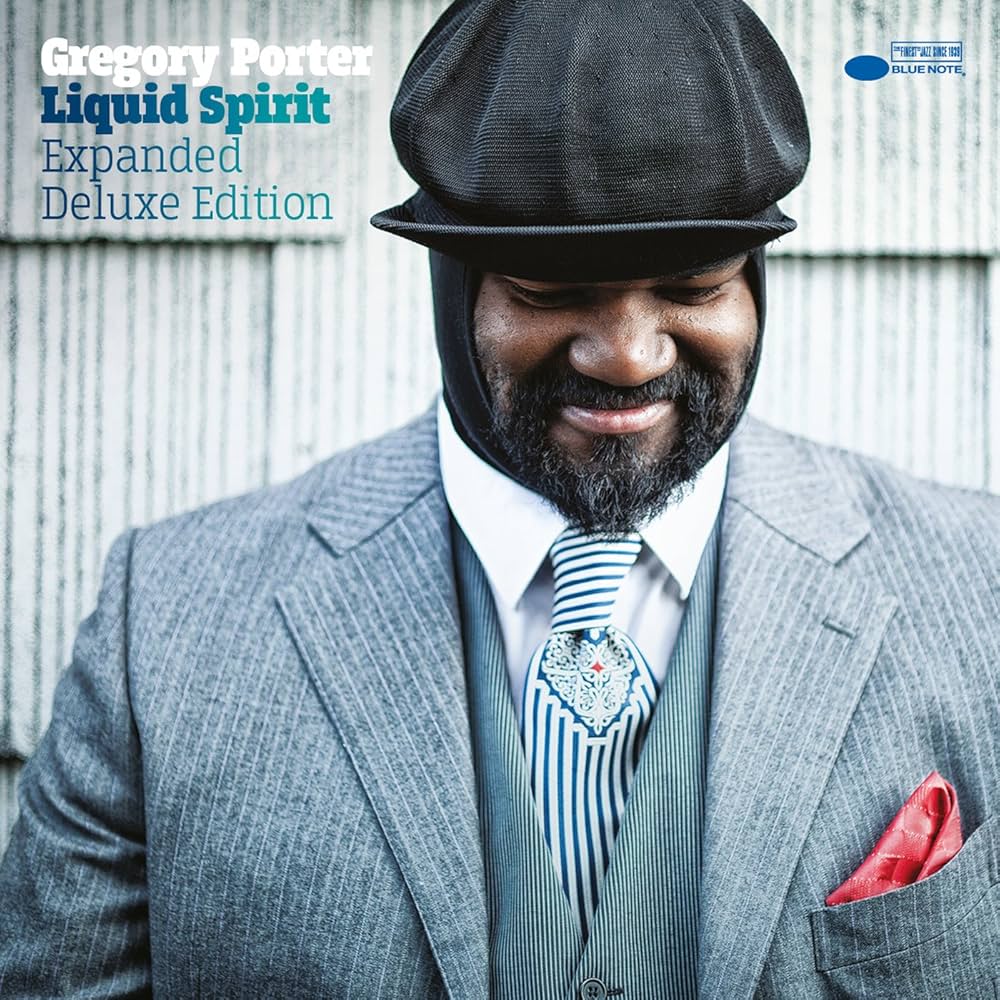
Gregory Porter, “Liquid Spirit”
Gregory Porter’s “No Love Dying” from the Liquid Spirit album is a very intimate style of Jazz performance. The Amphions translated that intimate feeling successfully and I felt like I had a detailed look into the recording session. Porter’s voice was precisely placed, dead center between the speakers, and had a lovely purity of tone to it. His vocals, the accompanying piano, and the saxophone were crystal clear. Even as I turned up the volume on the Krypton3X everything in that midrange area sounded especially clean and detailed. The saxophone solo was especially noteworthy as I could hear details in the breaths the performer was making. Those dual 8-inch drivers were also helping give that sax an extra sense of weight and dimension to go with the clarity I was experiencing. The low-frequency impact of the acoustic bass was excellent, sounding tight and well-controlled through the speakers. This contrasted nicely with the subtlety of brushwork on the drum skins and cymbals that the Krypton3X were faithfully recreating.

Lisa, “The First Take”
“Gurenge” performed by Japanese artist Lisa and recorded for the YouTube channel “The First Take” is simply a live recorded female vocal with piano and it sounds brilliant on the Krypton3X! I found myself consistently turning up the volume on these speakers with this song as both the vocals and the piano playing got rather intense at various points, and it just kept sounding better and better to me the louder the speakers got. Just like with the Gregory Porter track, Lisa’s voice sounded wonderfully clean and clear, allowing every emotional nuance to be felt as well as heard. The more intense piano passages spent much of their time in the lower registers which was just fine with these speakers as the full weight and power of the notes came through solidly and convincingly. The Amphion Krypton3X have a deep dynamic capacity which makes them sound larger than they are and exhibit no signs of compression or distortion the louder they get.

Joe Hisaishi, Royal Philharmonic Orchestra, “A Symphonic Celebration – Music from the Studio Ghibli Films of Hayao Miyazaki”
Joe Hisaishi’s “A Town with an Ocean View” from the movie “Kiki’s Delivery Service” is a big, lush orchestral piece that starts modestly with the individual sections playing their own parts and then combining into the full orchestra at the main refrain. It’s a big-scale performance and, when you turned them up, the Krypton3X delivers that sense of scale convincingly. The individual details and subtleties of instruments like the flutes and the woodwinds come through clearly while they are the focus, while when the full orchestra comes together it feels like a full orchestra coming out of these speakers. The image, depth, and impact are all there in spades.

Slash, “Orgy of the Damned”
The classic Fleetwood Mac chestnut “Oh Well” interpreted by Slash and Chris Stapleton is a bit of high-powered blues/rock with some killer distorted guitar solos and a kicking bass drum. This is one of the better modern renditions of this classic track that I have come across. The opening acoustic guitar has a nice detailed “twang” coming through the Amphion’s midrange drivers. At the same time, the big woofers deliver the beat of the accompanying kick drum with authority and set you up for what’s to come. Then Slash’s electric guitar comes in with its edgy cackle that establishes the familiar refrain. It sounds nicely weighted without getting too thin to the ears. Chris Stapleton’s vocals are properly centered and don’t display a ton of dimension, but that’s part of the recording. The cowbell sounds good, properly hollow, and metallic with good reverb (honestly, we always can use more cowbell). Then all the stops get pulled with Slash going into a full rampaging guitar solo along with the rhythm guitar, drums, crashing cymbals, and bass in hot pursuit. It’s high volume and busy but the Krypton3x does not allow the whole production to blend into mush. Everything is well-delineated, and each instrument can be honed in on even with Slash’s Les Paul in the forefront. Of course, I had to turn this up on the Amphions and they didn’t even break a sweat playing this back at a slightly stupid volume level. Too much fun!
Secrets Sponsor
Bench tests were performed with a Cross-Spectrum Labs calibrated UMIK-2 microphone connected to my computer workstation using Room EQ Wizard acoustic measurement software. Unlike measurements taken outdoors or in an anechoic chamber that measures a speaker in isolation, in-room measurements give a sense of how a speaker behaves in the actual environment in which it’s used. Both types of measurements are valuable (make no mistake, a properly designed speaker in an anechoic environment will hold up much better when used in an average listening space), I just find in-room measurements interesting as they help shed light on what I am hearing (in my room) and why.
All near-field measurements were done with the mic at a 1-meter distance from the speaker, with the microphone capsule centered on the tweeter axis. The speaker was positioned as far away from any walls as possible.
 This in-room measurement is an 18-point spatial average. A 9-point measurement was made for the right speaker and then repeated for the left speaker. Averaging both speakers is an approach others have been using and publishing. Using data from both speakers reduces the modal response of the room by averaging the differences in the response of the two speakers from room asymmetries. The technique cannot eliminate them, however, so the response below 300 Hz remains room-dominated. Despite some of the lumps and bumps in the response, the Amphion Krypton3X maintains a generally uniform performance throughout its bandwidth. The bass section shows solid extension down to 27 Hz before falling off. If it wasn’t for the 20 Hz null in this room, the speakers might have extended a little lower. Factoring in that the dips between 130 Hz to 180 Hz and 200 Hz to 320 Hz are more room-related, the speakers show a bit of a peak at 440 Hz and a significant dip between 800 Hz to 1500 Hz. There is also as much as a 3dB peak at 3 kHz (possibly room-related as it doesn’t appear in the listening window measurements) after which the response is quite uniform until the treble starts to dip past 15 kHz with a rise back up at 20 kHz.
This in-room measurement is an 18-point spatial average. A 9-point measurement was made for the right speaker and then repeated for the left speaker. Averaging both speakers is an approach others have been using and publishing. Using data from both speakers reduces the modal response of the room by averaging the differences in the response of the two speakers from room asymmetries. The technique cannot eliminate them, however, so the response below 300 Hz remains room-dominated. Despite some of the lumps and bumps in the response, the Amphion Krypton3X maintains a generally uniform performance throughout its bandwidth. The bass section shows solid extension down to 27 Hz before falling off. If it wasn’t for the 20 Hz null in this room, the speakers might have extended a little lower. Factoring in that the dips between 130 Hz to 180 Hz and 200 Hz to 320 Hz are more room-related, the speakers show a bit of a peak at 440 Hz and a significant dip between 800 Hz to 1500 Hz. There is also as much as a 3dB peak at 3 kHz (possibly room-related as it doesn’t appear in the listening window measurements) after which the response is quite uniform until the treble starts to dip past 15 kHz with a rise back up at 20 kHz.
This is a plot of the NRC listening window for the Amphion Krypton3X scaled from 300 Hz on up which is averaged from the following measurements: 0-degree on-axis, +/-15-degrees vertical, and +/-15-degrees horizontal. This is the portion of the frequency range that is dominated by the speaker (response below 300 Hz tends to be dominated by the room and can vary greatly).
David Rich notes:
This is a big speaker, and Carlo is testing it in a room. It cannot be lifted from the ground. Because of the setup limitations, I needed a very small window to remove the reflections. The oscillations below 700 Hz are window-related.
This is a plot of the CEA-2034A listening window for the Amphion Krypton3X scaled from 300 Hz on up which is averaged from the following measurements: 0-degree on-axis, +/-10-degrees vertical, +/-10-degrees, and +/- 20-degrees horizontal. This is the portion of the frequency range that is dominated by the speaker (response below 300 Hz tends to be dominated by the room and can vary greatly).
David Rich notes:
Nothing significant changes between the NRC and CEA-2034A listening windows. The CEA- 2034A also has vertical measurements which produce a similar dip to the NRC window.
Above are the normalized horizontal radiation curves of the Amphion Krypton3X from 0 to 90 degrees, scaled from 300 Hz on up, measured in-room in the near field.
David Rich notes:
This is impressive above 1kHz. The waveguide is doing its job, and the crossover to the large 8-inch woofers is well-integrated. Very few diffraction effects are seen. Below 1 kHz, what you are seeing is likely room reflection, which is not being fully attenuated by the 4 msec window. This also results in the oscillation you see. Off-axis radiation decreases rapidly with increasing angle. This is the dipole design. Unfortunately, the limitation of a large speaker being measured indoors prevents seeing the dipole effect below 1 kHz.
The Amphion-supplied polar globe plot in the “Design” section gives an idea of the radiation pattern below 1 kHz
Note the substantial attenuation at 90 degrees. At that angle, the mic is at the side vents, which radiate out of phase with the sound coming from the front of the cone.
Moving to the vertical radiation pattern for positive angles, we see the plots of 0 to +20 degrees, scaled from 300 Hz on up, measured in-room in the near field.
David Rich notes:
An 8-inch midrange above and below the tweeter results in significant cancelation past 5 degrees in the vertical plane.
Since the listening window shown above includes vertical measurements in the 10-degree (CEA) or 15-degree (NRC) range, this dip is visible in the windows
Here we have the vertical radiation pattern for negative angles, we see the plots for 0 to -20 degrees, scaled from 300 Hz on up, measured in-room in the near field.
Here we have the Impedance sweep for the Amphion Krypton3X. The results show that the speaker remains below 6 Ohms from 5 Hz to 12 Hz, and from 50 Hz to 400 Hz. Through the rest of the speaker’s range, with a peak as high as 37 ohms at 4 kHz and 16 Ohms at 40 Hz, the speaker’s impedance stays well above 8 Ohms. Between 80 Hz to 120 Hz, the speaker’s impedance reaches a low of 3.2 Ohms. The Amphion Krypton3X specifications rate its nominal impedance as 4 ohms which may be more worst-case as opposed to nominal.
The Amphion Krypton3X is a competitive large, floor-standing speaker that can play with the best in its field. It deserves a little more notoriety!
- Big, Beautiful sound. Thank you, cardioid dispersion.
- Super-clear and slightly forward midrange.
- Smooth, enjoyable treble.
- Great bass extension.
- Classy, understated looks. I’ll take the Walnut!
- A little smoother measured performance from a speaker with a studio pedigree.
- A little wider soundstage would be fun.
The Amphion Krypton3X is a desirable loudspeaker on both an aesthetic and sonic level. While large in stature, it has an understated elegance to its design that makes it more appealing and seem less obtrusive than some other big floor-standers. When listening to the Krypton3X it becomes very easy to get lost in what you are hearing. They sound BIG when pushed, and while they will happily run off a solid 100-watt amplifier, they do appreciate some more power to get that bass really cooking. I found them to be appealing speakers to listen to with all kinds of music. They are also one of those speakers that demand to be turned up louder, sounding better and better as the volume gets higher. No sense of compression or distress whatsoever from these Finnish beauties, just know that you can’t get the best out of them listening passively while doing other things. You need to sit down and make time for them. They aren’t a speaker chock full of bells and whistles, just some very intelligent design that has been thoughtfully executed. If you are looking for a powerful tower loudspeaker that has some serious “lung capacity,” produces great sound, and cuts a stylish figure, the Amphion Krypton3X should be on your shortlist.
Note: The author wishes to thank David Rich for his invaluable assistance with this review.


